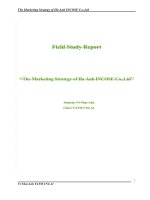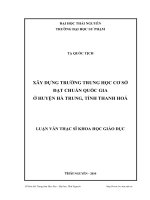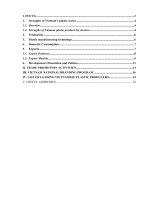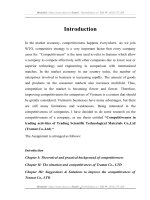Selling activities of Ha Trung Plastic Technology JSC
Bạn đang xem bản rút gọn của tài liệu. Xem và tải ngay bản đầy đủ của tài liệu tại đây (534.12 KB, 34 trang )
Website: Email : Tel (: 0918.775.368
Introduction
Viet Nam ‘s effort to restructure the economy really got underway with the
Sixth Party Congress held in December 1986. Our economic structure mechanism
was really changed from planned market oriented economy to market oriented
economy. Then Vietnam's membership in the ASEAN Free Trade Area (AFTA)
and entry into force of the US-Vietnam Bilateral Trade Agreement in December
2001 have led to even more rapid changes in Vietnam's trade and economic
regime. Following over a decade long negotiation process, Viet Nam became the
official one of members of WTO in January 2007. The economy have moved to
implement the structural reforms needed to modernize itself and to support more
competitive, export-driven industries. This fast economic development results that
the main target of every Vietnamese enterprises is how to complete with other
domestic and foreign enterprises.
Getting to know of the importance of changing, during probation period at
Ha Trung Plastic Technology Joint Stock Company( Ha Trung JSC), I have
decided to choose the subject “Selling activities of Ha Trung Plastic Technology
JSC ” for my graduation thesis.
In my view, this is interesting subject. Many researchers is trying to
research and set up detail marketing plans as well as selling plans for their own
product.
I would like to thank my supervisor Nguyen Luong Long MBA for his
coaching and comments during the carrying out of thesis. Without the intensive
assistance of my supervisor the results of this thesis would never have been
possible.
Further, I would like to thank all professors of Hanoi University of Business
and Technology and Managers of Ha Trung JSC for their support and kindness
toward me.
1
Website: Email : Tel (: 0918.775.368
Chapter 1. theoretical and practical background
I/ Theoretical background
1/ Selling:
Selling is a process by which one person guides other people's behavior
along a path in a desired direction, culminating in the purchase of a product or
service.Good selling is convincing someone of something they didn’t think they
needed, they buy it and love it and realize they did need it!! Life insurance, or car
breakdown and recovery cover, or double glazing, or a mobile phone agreement.
The most of the skills are out there in the public domain, more so than ever before.
It’s like how we learn to use the Internet: somehow, we soak up the universal
knowledge.
Many people know what it takes to be good at selling, it’s just a matter of
applying it. Sellers know there’s enough books and stuff on the Internet, and if
sellers have got the driver and motivation to read them, then they are likely to have
the same drive that makes them good and successful at selling.
The selling concept is practiced most aggressively with unsought goods -
goods that buyers normally do not think of buying, such as insurance and funeral
plots. The selling concept is also practiced in the nonprofit area by fund-raisers,
college admissions offices and political parties. Most firms practice the selling
concept when they have overcapacity. Their aim is to sell what they make rather
than make what the market wants. In modern industrial economies, productive
capacity has been built up to a point where most markets are buyer markets( the
buyers are dominant) and sellers have to scramble for customers. Prospects are
bombarded with sales messages. As a results, the public often identifies
marketing with hard selling and advertising.
However, marketing based in hard selling carries high risks. If assumes that
customers who are coaxed into buying a product will like it: and if they don’t, that
they won’t bad-mouth or complain to customer organizations and will forget their
disappointment and buy it again. These are indefensible assumptions. One study
2
Website: Email : Tel (: 0918.775.368
showed that dissatisfied customers may bad-mouth the product to 10 or more
acquaintances: today bad news travel even faster and father with the Internet.
2. Types of Selling
- Service-Oriented Selling
The focus is on the product -- communication information about products,
merchandise or services. The sole function of the salesperson is to process sales
transactions. Consumers make their own decisions about how the product satisfies
their needs.
Service sales are the easiest to make.
- Developmental Selling
+ The focus is on the customer. The product is positioned by the salespeople
in relation to the needs of prospects.
+ Involves much more creativity than service selling.
+ Requires acquiring knowledge about the market, economy, client..
2/ Selling process
Most of sale professionals agree on the major steps ( see chart 1) involved in
any effective sale process as follows:
- Prospecting and qualifying : The first step in selling is identifying and
qualifying prospects. The purpose of this step is to find potential buyer who have a
need for your product, the ability to afford it, the authority to make the buying
decision. For instance, sales representatives at Gulfs tram Aerospace, which sells
corporate jets, focus their selling effort at those finite number of company that can
afford to buy jets and at the top executive who will benefit most and who have
authority to approve the purchase.
- Preapproach: the successful salesperson prepares before actually making
the first cal, learning as much as possible about the prospect (whenever a person or
company) and the prospect’s want and needs. Then the salesperson should plan a
strategy – including determining the best initial contact approach (phone, visit,
letter, email) and selecting the right time to make that initial contact.
- Approach: in the initial contact, the salesperson will want to make a good
first impression and begin building a rapport with the customer. Little things –
3
Website: Email : Tel (: 0918.775.368
dress attire, use of language, mannerisms –may seem superficial but the
contribute to that first impression. In some businesses, it can take years to make an
eventual sale. For instance, a sales rep at Herman Miller, the furniture
manufacturer, spent ten years calling on the Pentagon before he landed a major
contact. The approach step in the sales process lays the foundation for building
and continuing a relationship.
- Presentation and demonstration: the presentation and demonstration must
be tailored to the customer’s needs. The salesperson needs to effectively grab the
customer’s interest and arouse desire. A good sales presentation will describe the
product’s futures, advantage, benefits and value- all in terms of the customer’s
point of view. Company like Xerox, Cisco systems and Guffstream Aerospace
invest heavily in sales training to ensure that their salespeople know their products
inside and out.
- Overcoming objections : customer almost always have questions and doubts
.It’s the salesperson’s responsibility to overcome them. Objections shouldn’t be
seen as negative or threatening. They’re natural part of the sales process. But a
trained and knowledgeable salesperson- one who knows both the product being
sold and potential customer’s needs- is equipped to successfully overcome
objections.
4
Website: Email : Tel (: 0918.775.368
Chart 1. The seven steps in effective selling;
5
PrpProspecting
and qualifying
Preapproach
Presentation
Demonstra
tion
Approach
Overcoming
objections
Closing
Follow up
Website: Email : Tel (: 0918.775.368
- Closing : the successful sales has the confidence and timing to know when
to “ask for the sale”. Sales training programs typically include a number of
techniques that can be effective closer .
- Follow-up: Selling should be viewed as part of creating a relationship. As
such, the sale isn’t over when the customer says yes and an order is written. The
end goal is a satisfied customers. To ensure that goal is reached, the effective
salesperson makes a follow- up call to certify that the order was received in the
condition expected, to make sure the customer is happy with the product, and to
ask what additional service if any the sales representative can provide.
3. Practical background of VietNam Plastic Industry
The plastic industry commenced almost half a century ago in Vietnam;
however, the production remained limited and diminutive until recent years. Thus,
the Vietnamese plastic industry is considered still in its infancy compared to that
of other countries in the region like Malaysia, Singapore, Thailand and China. By
way of comparison, Vietnam’s production output of plastics per capita was 25 kg
of plastic per person in 2005, and is expected to rise to 40 kg per capita by 2010.
Although this is a rapid increase, plastic output per capita of Malaysia in 1999 was
49kg, five times higher than Vietnam’s figure in the same year (9.4kg).
Singapore’s output per capita for the same year was 10 times higher and
Thailand’s was three times greater and even Indonesia was two times greater for
the same period.
Currently, there are about 2700 plastic corporations in Vietnam, 80% of
which are of small or medium size and privately owned. Only 6% are state-owned,
but they represent about 20% of the total capital invested in the industry. State-
owned companies tend to be larger and to employee more workers and have a
greater investment total than their small or medium sized private competitors. The
rest are foreign invested enterprises, with about 35% in terms of overall capital
investment.
Despite its somewhat smaller size than competitor markets in China,
Thailand and Malaysia, plastics is a growth industry in Vietnam with an annual
growth rate of around 30 percent per year in recent years. This growth has made
6
Website: Email : Tel (: 0918.775.368
plastics a major export earner for the country. In 2005, Plastics was third after
coal and rice as the fastest growing sector despite the rapid rise of petroleum and
other inputs that caused major jumps in plastic resins prices. This growth has
been noted particularly by regional competitors such as Malaysia which has
responded by investing to try to develop new markets. Examples of this are Poly
Tower Ventures Bhd, and Tong Guan Industries Berhad are both opening
factories in Vietnam shortly , in order to gain both local market share and to be
able to take more orders from EU and the U.S..
7
Website: Email : Tel (: 0918.775.368
Chart 2
Plastics are one of the most important and versatile materials in the global
economy. Plastics are durable, strong, lightweight, and resistant to chemicals; they
can be transparent, translucent, or opaque; soft, flexible, or hard; insulators or
conductors of heat and electricity. They can be fabricated into almost any shape
and size. And they are recyclable using multiple resource recovery options. From
packaging to aerospace applications, plastics provide designers, engineers,
manufacturers, and consumers with products that contribute to economic growth,
sustainability of the environment, and a higher standard of living worldwide.
Inherently light weight, plastics are an efficient use of natural resources. Plastic
products are used as the basis for manufactured articles (such as toys) and as
components of manufactured products (such as automobiles) making plastics an
important and strategic factor in economies in which manufacturing plays a
significant role. As developing countries enter into the manufacturing stage of
economic development, plastics will continue to grow in importance. There is
already international trade in end-of-life products for the purpose of reclaiming or
recycling the plastic components. Plastics products figure in all nine ISO technical
8
Website: Email : Tel (: 0918.775.368
sectors: Agriculture and food technology; Construction; Electronics, information
technology and telecommunications; Engineering Technology; Generalities,
infrastructure and sciences; Health, safety and environment; Materials
technologies; Special technologies; Transport and distribution of goods.
The national plastic industry produces virtually all of what the domestic
market consumes and production is currently more oriented toward domestic
items and packaging vis- -vis export. Vietnam’s internal market is changing andà
increasingly there is more demand for hi-tech plastics products. Prior to 2004, all
Vietnamese plastic products were manufactured with genuine plastic resins. Since
then, to comply with the growing demand, the government has allowed the
imports of cheaper plastic scrap: Vietnam is Asia’s second largest importer of
plastic materials. Nonetheless, such fact is raising an issue as raw plastic material
prices have soared recently. The plastics industry in Vietnam tends to be highly
labor intensive. A survey in 2004 revealed that 70% of the labor force in the
Vietnamese plastic industry is unskilled, seven times higher than the combined
average of other sectors. Most plastics companies employ between 10 and 50
people. The average monthly salary for a plastics industry employee is just under 2
million VND, with a large degree of variation depending on whether the company
is foreign or locally owned and dependent on location of the factory facility.
The development strategy of Vietnam's plastics industry to 2010 has stated
that the industry will need investment of US$ 3 billion to achieve industry goals.
The plan outlines an integrated plastics industry where raw materials would be
almost exclusively supplied by in-country resources and product is both used for
domestic selling and export. By 2005, 30% of the industry's demand on materials
should be supplied domestically, lessening its heavy dependence on imports. The
industry will focus on replacing and upgrading machinery and equipment for raw
material production and hi-tech products such as construction materials, parts for
the auto, motorcycle, and refrigeration equipment industries...
The Vietnamese plastics industry is highly dependent on imports. Currently
the Vietnamese plastic industry must import about 1.5 - 2 million tons of raw
materials annually, plus hundreds of auxiliary chemicals used in the plastics
9
Website: Email : Tel (: 0918.775.368
industry. Domestic raw materials can meet only 30 percent of the country’s
demand. In 2004 Vietnam was Asia’s second largest importer of plastics
materials. The Vietnamese government is attempting to promote import
substitution by helping to finance several domestic production facilities but the
government forecasts that Vietnam will still have to import roughly half of the
resins it needs after these production facilities are completed in 2010.
Vietnam is dependent upon polyethylene (PE), polypropylene (PP), polyvinyl
chloride E (PVCE) and polyvinyl styrene (PS) imported from abroad. Vietnam is
less dependent upon imports of B oriented polypropylene (BOPP), polyvinyl
chloride S (PVCS) and dioctyl phthalate (DOP) resins as growing amounts of this
are being produced domestically - supply is still inadequate to meet demand.
The major plastic exporters to Vietnam are regional countries such as China,
South Korea, Japan and Taiwan. In 2005, Vietnam imported 1,147 MT of both raw
materials and finished products. The plastic import value was $1,426mil, equal to
four times of export value of $350 in 2005. In 2004, Vietnam exported only 10
percent of total output, i.e. 90 percent for domestic demand (VPA).
Vietnamese plastics products have been shipped to many countries, such as
Cambodia, Laos, India, Sri Lanka, Japan, China, the EU, Taiwan and the US.
Investment opportunities exist in the packaging field, plastics machinery
production, plastics resin production and waste plastics reprocessing sub-sectors.
10
Website: Email : Tel (: 0918.775.368
Chapter2. the situation and selling of hatrung
plastic technology joint stock company
I. The outlines of HaTrung JSC
1. The history of Ha Trung JSC
HaTrung company is based in 551 Nguyen Van Cu, Long Bien district, Ha
Noi, is a joint stock company which started on 1/6/1994 with business registration
number 0103004549.
Company provides a broad range of plastic bags, packaging supplies and poly
tubing, food services and industrial packaging markets, nylons and super market
bags, goods relate plastic...Plastic goods comes up to the standard ISO 4427 :
1996, TCVN 7305 : 2003 , BS 3505:1968, AS/NZS 1477:1996,..
Being one of a few known plastics company in Vietnam having in-line a
mold design and manufacture site and workshops with blow and injection molding
technology. Ha Trung is always committed to right timing and good control of
quality products. Applying the quality control system ISO 9001 helps Ha Trung to
make good control of the process and ensure customers’ satisfaction.
Ha Trung’s factory is equipped with modern machines and tools, and they
are always upgraded annually by famous providers as K Krauss-Maffei,
Cincinnati, Corma,... In parallel, Ha Trung’s engineers and staffs are well and
professionally trained. With these advantages, products of Ha Trung and precision
molds always are the first choice of customers in the Vietnamese market.
2. Management and organization structure
Ha Trung company’s organization has line-functional structure. With this
structure, company has a clear line or chain of command running down from
highest passions to lowest positions. All people in the organization know what
decisions they are able to make, who their superior( or boss) is ( to whom they
report), and who their immediate subordinates are( to whom they can give
instructions).
Chart3: The company organizational structure
11
Board of director
Website: Email : Tel (: 0918.775.368
a.Board of director: (CEO and Deputy Directorare responsible for setting
sales and profit goals for every year that are elaborated into specific goals for each
lower level .
- The chief executive officer and his Deputy is the most important role in
the management of an organization.
+ They are leaders of company, always give advises the board
+ Advocates / promotes organization and stakeholder change related to
organization mission
+ Supports motivation of employees in organization products/ programs and
operations
- They have a visionary and give information bearer:
+ Ensures staff and Board have sufficient and up-to-date information
+ Looks to the future for change opportunities
+ Interfaces between Board and employees
+ Interfaces between organization and community
- And they are decision marker:
+ Formulates policies and planning recommendations to the
Board
+ Decides or guides courses of action in operations by staff
- They are managers in the company:
+ Oversees operations of organization
+ Implements plans
+ Manages human resources of organization
+ Manages financial and physical resource
- They are a board developer:
12
Marketing department
Accounting depart Production depart Agency management
depart
Website: Email : Tel (: 0918.775.368
+ Assists in the selection and evaluation of board members
+ Makes recommendations, supports Board during orientation and self-
evaluation
+ Supports Board's evaluation of Chief Executive
b. The Marketing Department
+ The marketing organization consists of functional specialists: geographic
area, product or customer markets ( such as the sales manager and marketing
research manager) who report to a marketing vice president, who coordinate their
activities. They research market and give tactics, strategies to compete.
+ Managers finds market, makes relationship with customers, solving and
customer care, increasingly please regional and local sale group, understand and
deal with individual customers rather with the mass market or even market
segments.
+ Examining whether the planned results are being achieve. Marketers study
strategies, strength and weak of product to compete with competitor’s .
+ Marketers today are showing a growing interest in developing better
marketing metrics for measuring marketing performance.
c. Production department
Production is the functional area responsible for turning inputs into finished
outputs through a series of production processes. The Production Manager is
responsible for making sure that raw materials are provided and made into
finished goods effectively. He or she must make sure that work is carried out
smoothly, and must supervise procedures for making work more efficient and
more enjoyable. In a manufacturing company the production function may be split
into five sub-functions:
1. The production and planning section will set standards and targets for
each section of the production process. The quantity and quality of products
coming off a production line will be closely monitored. In businesses focusing on
lean production, quality will be monitored by all employees at every stage of
production, rather than at the end as is the case for businesses using a quality
control approach.
13








![[Luận văn]nghiên cứu đặc điểm sinh học, sinh thái và biện pháp phòng trừ một số loài xén tóc chính hại mía tại hà trung, tỉnh thanh hoá](https://media.store123doc.com/images/document/13/ve/hi/medium_hia1384942734.jpg)
